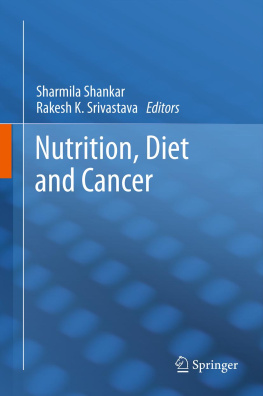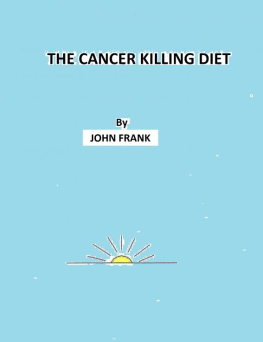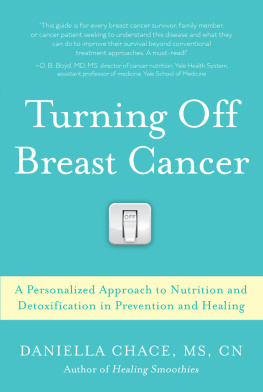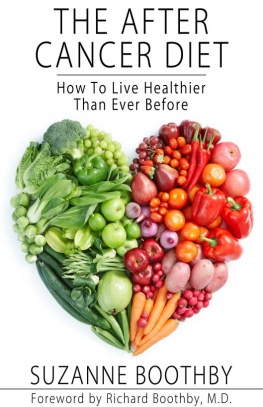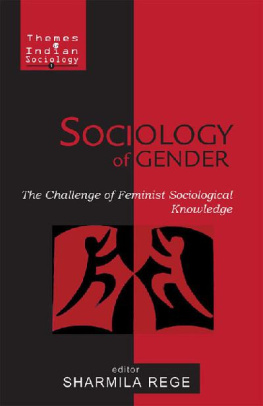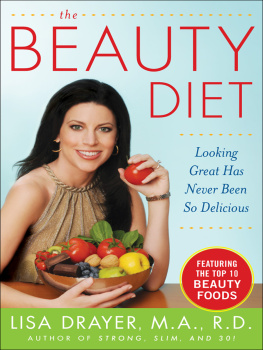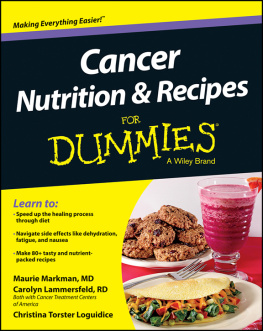Sharmila Shankar - Nutrition, Diet and Cancer
Here you can read online Sharmila Shankar - Nutrition, Diet and Cancer full text of the book (entire story) in english for free. Download pdf and epub, get meaning, cover and reviews about this ebook. City: Dordrecht, publisher: Springer Netherlands, genre: Romance novel. Description of the work, (preface) as well as reviews are available. Best literature library LitArk.com created for fans of good reading and offers a wide selection of genres:
Romance novel
Science fiction
Adventure
Detective
Science
History
Home and family
Prose
Art
Politics
Computer
Non-fiction
Religion
Business
Children
Humor
Choose a favorite category and find really read worthwhile books. Enjoy immersion in the world of imagination, feel the emotions of the characters or learn something new for yourself, make an fascinating discovery.
- Book:Nutrition, Diet and Cancer
- Author:
- Publisher:Springer Netherlands
- Genre:
- City:Dordrecht
- Rating:5 / 5
- Favourites:Add to favourites
- Your mark:
- 100
- 1
- 2
- 3
- 4
- 5
Nutrition, Diet and Cancer: summary, description and annotation
We offer to read an annotation, description, summary or preface (depends on what the author of the book "Nutrition, Diet and Cancer" wrote himself). If you haven't found the necessary information about the book — write in the comments, we will try to find it.
Nutrition, Diet and Cancer — read online for free the complete book (whole text) full work
Below is the text of the book, divided by pages. System saving the place of the last page read, allows you to conveniently read the book "Nutrition, Diet and Cancer" online for free, without having to search again every time where you left off. Put a bookmark, and you can go to the page where you finished reading at any time.
Font size:
Interval:
Bookmark:
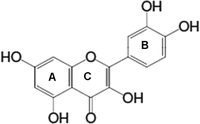
Type of study | Cell line/Animal tumor model | Mechanisms | Reference(s) |
|---|---|---|---|
In vitro | Human breast cancer cells, MDA-MB-231 | Increasing cytosolic Ca2+ levels | Choi et al. () |
Reducing mitochondrial transmembrane potential | |||
Activation of caspase-3, -8 and 9 | |||
Upregulation of Bax and AIF | |||
Downregulation of Bcl-2 | |||
Human cervical cancer cells, HeLa | Modulation of cell cycle regulatory proteins | Vidya Priyadarsini et al. () | |
Inhibition of NF-B activation | |||
Induction of G2/M cell cycle arrest | |||
Upregulation of bax, cytochrome C, Apaf-1 and caspases | |||
Downregulation of Bcl-2 and survivin | |||
Human colon adenocarcinoma cells (CO115, CaCo-2) | Induction of cell cycle arrest | Murtaza et al. () | |
Modulation of -catenin and MAPK signaling | |||
Downregulation of cell cycle associated genes | |||
Upregulation of tumor suppressor genes | |||
Human leukemia cells, HL-60 | Upregulation of FasL through activation of ERK and JNK | Lee et al. () | |
Activation of caspase-8 and Bid cleavage | |||
Induction of extrinsic apoptosis | |||
Promotion of histone H3 acetylation | |||
Human lung cancer cells, NCI-H209 | Induction of G2/M phase cell cycle arrest | Hung () | |
Upregulation of cyclin B, Cdc25c-ser-216-p and Wee1 | |||
Induction of apoptosis via caspase-3 cascade | |||
Human non-small cell lung cancer cells, NSCLC | Upregulation of death receptor-5 expression | Chen et al. () | |
Suppression of survivin expression | |||
Blockade of serine/threonine kinase Akt activity | |||
Human ovarian cancer cells, OVCAR-3 | Inhibition of cell proliferation | Luo et al. () | |
Decreased VEGF expression |
Type of study | Cell line/Animal tumor model | Mechanisms | Reference(s) |
|---|
Font size:
Interval:
Bookmark:
Similar books «Nutrition, Diet and Cancer»
Look at similar books to Nutrition, Diet and Cancer. We have selected literature similar in name and meaning in the hope of providing readers with more options to find new, interesting, not yet read works.
Discussion, reviews of the book Nutrition, Diet and Cancer and just readers' own opinions. Leave your comments, write what you think about the work, its meaning or the main characters. Specify what exactly you liked and what you didn't like, and why you think so.

